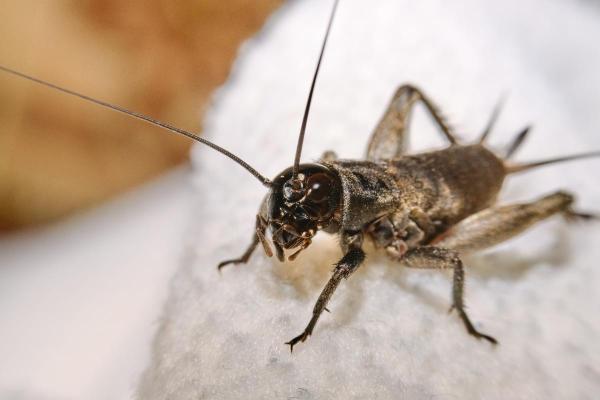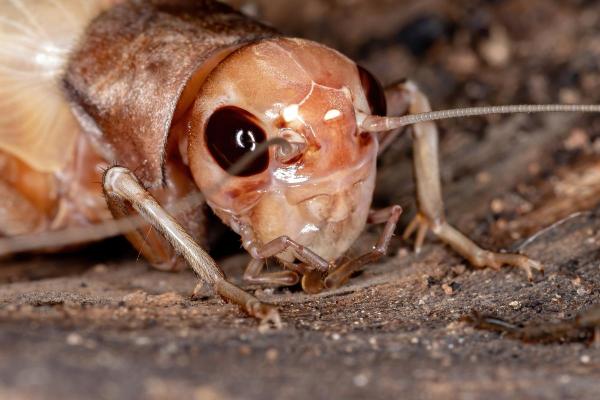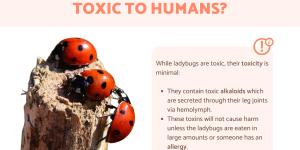Are Crickets Harmful to Humans?


Crickets are a group insects which have an almost global distribution. Exceptions include areas with extreme weather conditions such as the poles. With so many present in our world, it is unsurprising that the habitats of crickets often intersect with human settlements. Living in close proximity means we need to consider what possible threat crickets have to us. Many people who see a black cricket in particular wonder if they are poisonous or could otherwise cause us harm. While there are no poisonous crickets, we might worry if they can bite us or if they can cause any other types of damage.
At AnimalWised, we discover what this damage may be by asking are crickets harmful to humans? We look at whether they are poisonous, aggressive or in any other way dangerous to us.
Are crickets poisonous?
Insects are the most diverse animal species known to us. While many are harmless, many others have developed various mechanism either for protection or for predation. For example, some may have stingers which can incapacitate prey before consuming them. Others have become poisonous so that predators will avoid eating them. This can be seen with aposematism in animals which are brightly colored to alert potential predators of their harm.
In the case of crickets, these adaptations are not present. There are no known species of poisonous crickets. They do not produce toxic substances either for release or when they are eaten.
Do crickets bite?
Although crickets do not have venom or poison, there is some concern whether crickets bite. In particular, many people are worried whether black crickets are dangerous. Different species of cricket have different diets. All have chewing mouthparts. Some use them exclusively to feed on vegetation, while others are more omnivorous and eat other insects, including other types of cricket.
Despite having chewing mouthparts, they do not pose a significant risk to humans when biting. Even the largest cricket species will not have a bite that can cause significant harm, although there is always a concern with secondary bacterial infection. Black crickets are not more harmful than other species of cricket. Coloration is not important, but size can be a factor.
Some crickets may be more of a pest due to their ability to fly, not an ability shared by all cricket species. To learn more, check out our related article which asks how do crickets fly?

Are crickets harmful to humans?
In terms of bodily harm, crickets do not pose a threat to humans. As we have explained above, they do not have the ability envenomate, nor do their bites cause significant harm. They are also not aggressive towards humans. Crickets will be much more scared of us, avoiding our movements and hiding from our presence.
Crickets are mainly a type of nocturnal species, meaning they will be less active during the day. During daylight hours, they will hide under rocks, in cracks or camouflage themselves under leaves. Some may even dig into burrows into rotting wood or directly into the ground. In this way, crickets are not aggressive and will do all they can to avoid us.
One of the biggest concerns about crickets is their intimidating physical characteristics. They have long antennae and legs with serrated edges. They can seem to be dangerous, but they pose no real threat to humans. As stated above, even their pincer-like mandibles will not be able to cause a significant bite to us. If a cricket does bite us, we do not need to worry about poison or venom.
While they do not provide any direct threat to humans, it is important to consider all angles. It is possible that crickets can be infested with parasites or fungi. These can be spread to other crickets, but it is not known that crickets are vectors of disease which can affect humans. This means they do not carry zoonotic diseases, something which is common in other insects such as ticks and mosquitoes.
It is possible crickets can carry bacteria or viruses which might affect humans, but this is the same as any animal. They do not pose any significant global health threat in terms of disease or parasites. Since the possibility of transmission is low, it is not recommended to use insecticides if we have infestations of crickets. This applies even if they appear in large numbers, although this is a problem which will need to be assess on a case-by-case basis.
Grasshoppers are an insect related to crickets which can cause serious damage to crops when they swarm in very large numbers. When this occurs, grasshoppers are known as locusts and they can decimate crops. Crickets are not known to become locusts. It is possible that swarms of large numbers can affect crops. This is rare and they are not usually considered a significant threat to human agriculture. However, there are some crickets which may pose some threat. These are presented below.
Learn more about the differences between grasshoppers and crickets in our related article.
Types of dangerous crickets
As we have mentioned, there are no crickets that pose a direct threat to humans. However, there are some which are known to be pests and can cause more harm than others, especially when it comes to crop destruction. For this reason, we can see some examples below of crickets which can cause more harm than others:
Tobacco cricket (Brachytrupes membranaceus)
The tobacco cricket is a type of cricket native to Africa, of which four subspecies have been identified. Their habitat is located in different regions of the continent. This is a large cricket measuring between 4 to 5 cm and brown in color with a large head and strong legs.
This dangerous cricket is threatening to various crop plantations. Although it is common for it to attack tobacco plants, it can also attack other crops such as corn. The adults live underground in burrows that can measure up to about 80 cm and that are built by the crickets themselves. They store plant material on which they will later feed, usually young plants.
European mole cricket (Gryllotalpa grillotalpa)
Although its classification has changed and it is no longer placed within the group of true crickets, it is still commonly considered a type of cricket. Males can measure about 5 cm, while females up to 7 cm.
These are dangerous, but non-venomous crickets. They are equipped with strong and developed legs that they use to dig long burrows, something which is helpful since they always live underground. It develops in North Africa, Asia and Europe.
It is another crop pest. It has been known to cause damage to plantations of cereals, legumes, potatoes, beets, tobacco, strawberries, flax and others.
House cricket (Acheta domesticus)
Although this species is not reported to be harmful to crops and do not represent a danger to people or animals, in some cases they can swarm in large numbers. In these situations, male crickets produce a sound through stridulation, a process which consists of rubbing a specialized organ located on the forewing or tegmen. They do so to attract females or drive away other males depending on the type of sound.
When many crickets gather, some people may find the sound they produce at night annoying. Others consider this noise to be rather pleasant to hear.
Striped raspy cricket (Paragryllacris combusta)
It is a species from Australia, with a controversial taxonomy. As we have already explained, the bite of crickets is not significantly harmful. However, of all the cricket species, the striped raspy cricket is known to have a bite which is a little more painful than others. They still cannot envenomate and the bite won't cause significant harm, but they are best avoided and you should not pick one up if you spot one in the wild.
Learn more about the cricket's close relative with our article on how many legs do grasshoppers have?

If you want to read similar articles to Are Crickets Harmful to Humans?, we recommend you visit our Facts about the animal kingdom category.
- Aguirre, A., & Barranco, P. (2015). Order Orthoptera. Retrieved from: http://sea-entomologia.org/IDE@/revista_46.pdf
- BüttikerW, and Bünzli, G. (2009). Biological Notes on the Tobacco Cricket, Brachytrupes gallinaceus (Dru.) (Orthopt., Gryllidae), in Southern Rhodesia. Retrieved from: https://www.cambridge.org/core/journals/bulletin-of-entomological-research/article/abs/biological-notes-on-the-tobacco-cricket-brachytrupes-membranaceus-dru-orthopt-gryllidae -in-southern-rhodesia/4F452766B24258C2A8E2F48B62207064
- Ministry of Health of Peru. (2023). Presence of crickets in northern Peru: MINSA indicates that crickets do not transmit diseases nor represent a danger to human health. Retrieved from: http://www.digesa.minsa.gob.pe/noticias/junio2023/nota53.asp
- Orthoptera Species File. (2024). Retrieved from: http://orthoptera.archive.speciesfile.org/Common/entry/Login.aspx?Logo=1







